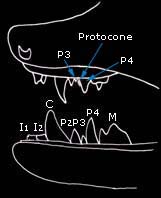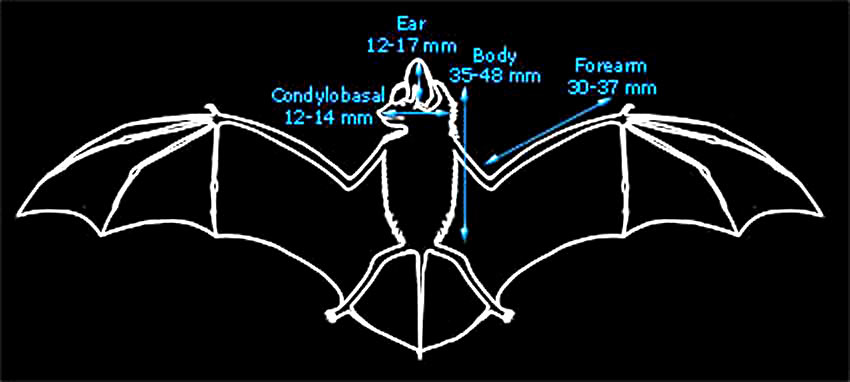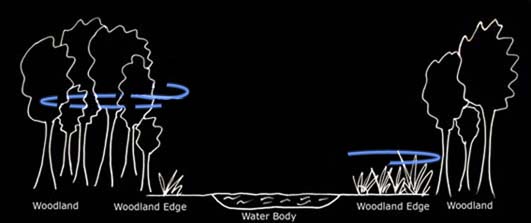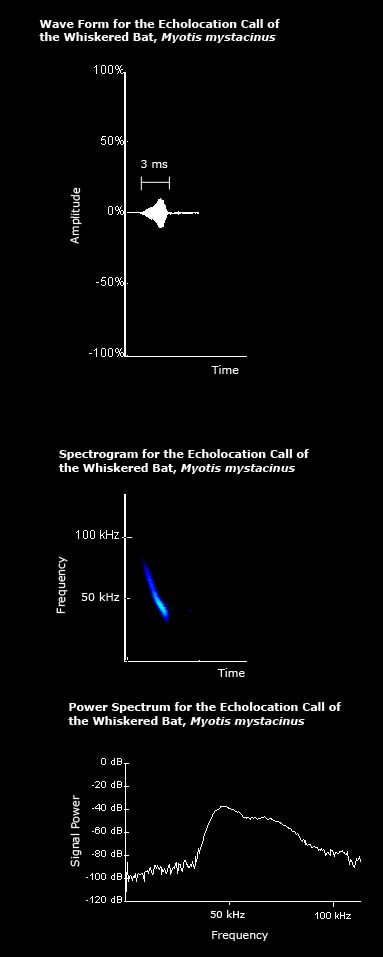Morphological Description
Life History
Distribution
Habitat
Roost Sites and Roosting Patterns
Emergence and Flight Pattern
Foraging Behaviour
Echolocation Calls
Status and Protection |
|
|
Morphological Description

- Dorsal fur is dark grey-brown with paler brown tips, tends to be darker than Brandt's bat. Ventral fur is dingy-white to grey.
- Juveniles up to 12 months are darker than adults and may be close to black.
- Fur is long and dishevelled.
- Whiskered and Brandt's bats are extremely similar and therefore easily confused. The teeth can be used to distinguish the two species. On the lower jaw of whiskered bats the third premolar (P3) is less than half the size of the second premolar (P2). On the upper jaw the protocone of P4 is small and shorter than P3(see diagram on left).
- Adult male whiskered bats have a thin parallel-sided penis while the whiskered bat has a club-shaped penis.
- Average weight (as given by Greenaway & Hutson, 1990) 4-8 g.
The diagram below gives important average body measurements for whiskered bats (Greenaway & Hutson, 1990).
|

Back to top |
Life History
- Mate from autumn to spring, inclusive of hibernation period.
- In Europe a single young is born from mid-June (Schober & Grimmberger, 1989).
- Maximum age recorded in Europe is 19 years but on average whiskered bats only live for four years (Schober & Grimmberger, 1989).
Back to top
|
Distribution |
|
|
 |
| The British and World distributions are shown by the white areas of the maps above (as given by Richardson, 2000 and Corbet & Harris, 1991 respectively). |
|
• Some uncertainty over the distribution of whiskered bats because they are not easily distinguished from Brandt's bats.
• Thought to be widespread, although not common, in England and Wales. May occur in Scotland although probably only in southern regions.
Back to top
|
Habitat |
|
• Open country, parks, gardens, villages, often near flowing water.
• Found in woodland but to a lesser extent than Brandt's bats.
• The photograph on the left shows a typical habitat of whiskered bats.
|
| Roost Sites and Patterns |
- Summer roosts: In Europe nursery roosts are found from May through to August (Schober & Grimmberger, 1989). Summer roosts usually contain 30-70 females, although up to 200 have been recorded (Greenaway & Hutson, 1990). Mainly roost in buildings (preferentially old buildings) but may also be found in trees. Roosts in buildings are found in lofts, narrow crevices and between timbers and stonework. Males are solitary in summer.
- Winter roosts: Found from September to March in cooler entrance regions of caves and similar environments (Greenaway & Hutson, 1990). Generally hang freely from the roof or wall but may also use crevices. Whiskered bats are either solitary or found in small groups over winter.
- Occasionally found in bat boxes.
- It is often very difficult to distinguish Whiskered and Brandt's bats, a problem which is exacerbated by the fact that both species often share roosts. Both whiskered and Brandt's bats have been found to show little or no difference in humidity and temperature requirements during hibernation, and the flight morphology of both species is remarkably similar (Jones, 1991).
Back to top
|
Emergence and Flight Pattern |
- Emerges early, possibly during the day between autumn and spring but more often at sunset. Thought to be active sporadically throughout the night (Stebbings, 1991c).
- Median emergence time is 32 minutes after sunset (Jones & Rydell, 1994).
- Flight is up to 20m above ground level (Stebbings, 1991c).
- Flight is agile and weaving but generally level with occasional glides and stoops.
- Flight speed is medium to fast.
Back to top
|
Foraging Behaviour |
|
Forages along woodland paths, close to vegetation and often in the canopy. Also forages in open habitats, including over flowing water.
The diet of whiskered bats mainly consists of Diptera including both crepuscular and diurnal species (Vaughan, 1997). Whiskered bats are therefore likely to use a gleaning foraging strategy.
Whiskered bats may take insects from the air by flying back and forth through a dense patch of insects or they may be taken directly from vegetation.
|
 |
|
Marked in blue on the diagram above is a typical foraging path of whiskered bats (based on Russ, 1999).
Back to top
|
Echolocation Calls |
|
|
 |
The echolocation call of whiskered bats is frequency modulated and sounds like short sharp clicks. |
|
To listen to the call of the whiskered bat click here
Size of sound file: 6.94KB
|

|
| For details of how the echolocation calls were recorded click here. |
|
Average values for a whiskered bat echolocation call, as given by Vaughan et al. (1997), are listed below:
Interpulse interval: 86.2 ms
Call duration: 4.7 ms
Minimum frequency: 41.0kHz
Maximum frequency: 64.4kHz
The spectrogram on the left shows clear frequency modulation, with the call beginning at high frequency and ending at a lower frequency.
The power spectrum on the left shows that the maximum power of the call is at a frequency of approximately 50 kHz.
|
Back to top
|
|
| Status and Protection
- The British pre-breeding population was estimated at 40,000 in 1995 (30,500 in England, 1500 in Scotland and 8000 in Wales) (Harris et al., 1995).
- Rare in eastern England .
- Whiskered bats are at low risk of extinction worldwide (IUCN status, 2001).
- Threatened by chemical treatment of timber.
- Nursery and winter should be protected, as well as suitable habitats.
Back to top
|
 © School of Biological Sciences, University of Bristol 2005. Last modified 24th February 2005. © School of Biological Sciences, University of Bristol 2005. Last modified 24th February 2005. |





 © School of Biological Sciences, University of Bristol 2005. Last modified 24th February 2005.
© School of Biological Sciences, University of Bristol 2005. Last modified 24th February 2005.